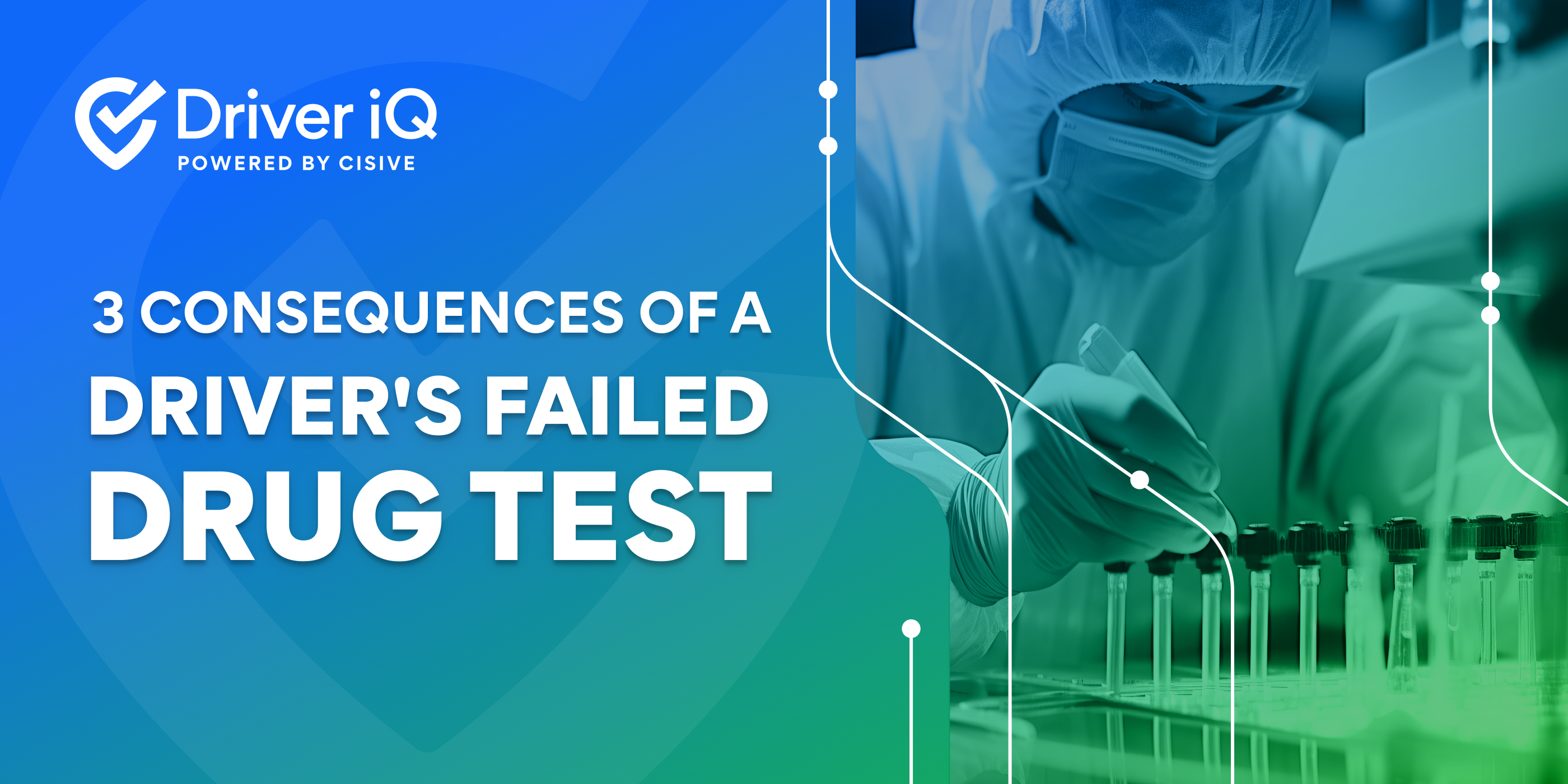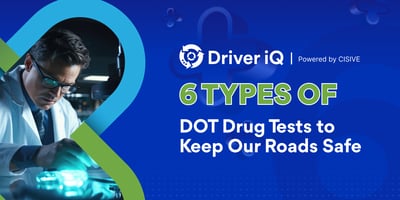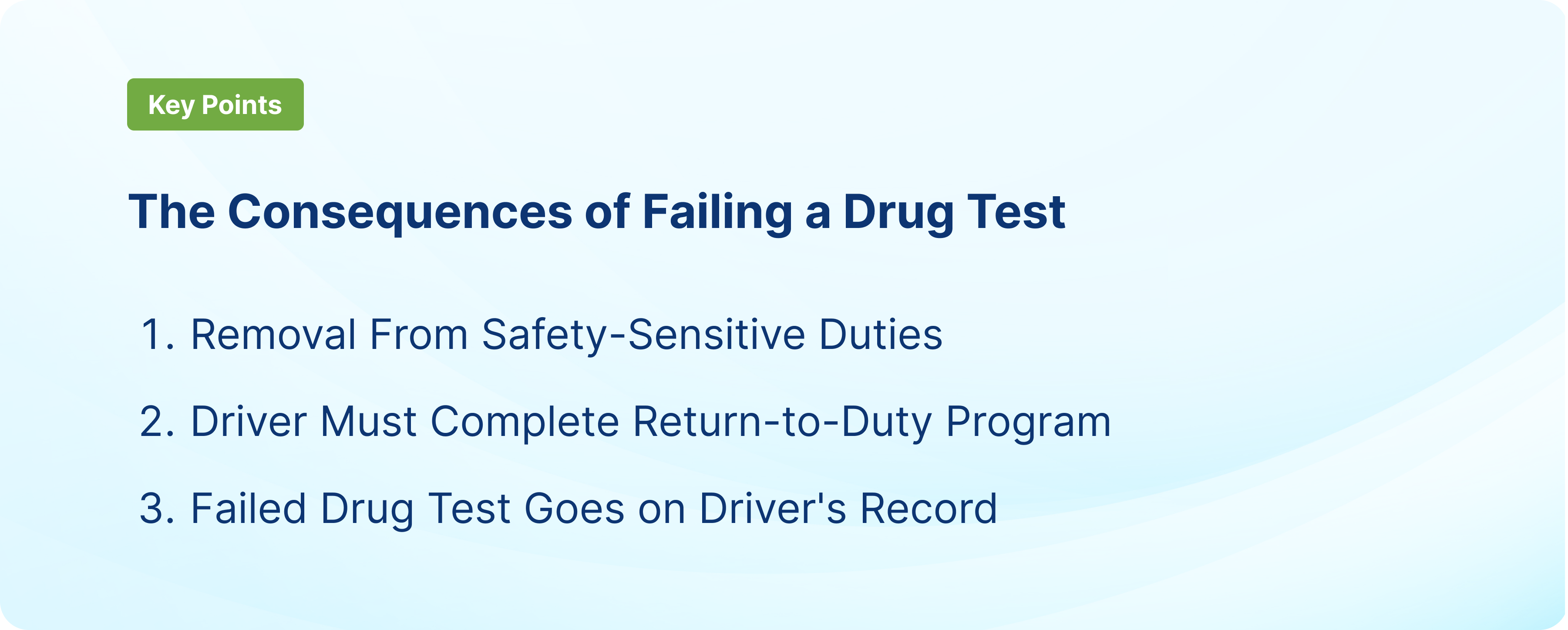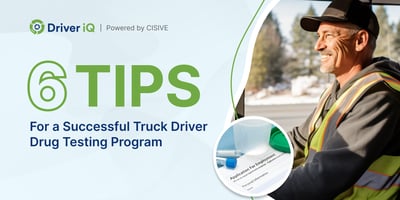

If you employ commercial drivers, your company is responsible for maintaining a formal drug testing...

DOT regulations require regular testing of employees in safety-sensitive jobs, including CDL drivers who operate commercial vehicles. This testing is designed to keep the public safe by identifying drivers who abuse drugs or alcohol.
The approved drug tests check for five substances. Typically conducted via a urine sample, the testing uses a split-specimen format to allow for a second test when needed.
A Medical Review Officer (MRO) will verify the results of the test. Failure happens if the sample tests positive for a substance. A failed test for alcohol measures a breath alcohol content that is 0.04 or higher. Refusing to take the test also counts as a failed drug test.
A CDL failed drug test impacts both the driver and the company with the effects, which include being removed from duty and completing a treatment plan. Learn more about the testing process, what causes a failed test, and what happens next for the driver and the agency.
Key Takeaways
|
DOT drug testing is federally mandated drug and alcohol testing for all drivers holding a commercial driver's license (CDL). The purpose is to keep the public safe by checking for CDL drivers who are under the influence of drugs or alcohol.
It's a five-panel drug test that tests for:
While there are many drug-testing methods available, DOT drug testing is typically conducted through a urine sample. However, blood tests might be used in some cases if the driver has certain medical conditions.
In the future, oral fluid testing could become an option for DOT drug testing. Currently, there aren't HHS-certified labs to conduct this type of testing.
Any company with CDL drivers who operate commercial vehicles on public roads must follow DOT testing guidelines. Testing happens at different points, including:
Recommended Reading: 6 Common Methods for Employee Drug Testing
The main cause of a CDL failed drug test is having a sample that tests positive for one of the five categories of drugs. On the alcohol portion, a failed test measures a breath alcohol content of 0.04 or higher.
Another way a driver can fail a DOT drug test is by refusing to take one. This is generally seen as the equivalent of a positive test result.
CDL drivers only have 3 hours to submit their urine samples. Leaving the collection site before finishing the testing site could be labeled as a refusal to take the test, which fails.
It's important for drivers to reveal any prescription drugs they take to avoid a positive result for them. Prescription drugs must be prescribed by a physician to the driver — anything that's not prescribed to the driver, even if it's an approved drug for drivers to use, could result in a failed test.
Whether the failure is due to a positive test result or a refusal to test, the driver must go through the return-to-duty process to reinstate their commercial driving privileges.
Recommended Reading: DOT Approves Oral Fluid Testing for Federally Regulated Drug Screening Programs
If you believe the test is a false positive, you can request for the urine sample to be tested again.
DOT drug tests use a split-specimen process where the urine sample is split into two. This provides a second sample if the first specimen comes back with a positive result.
An employee can request split specimen testing if the initial results come back positive. This request must happen within 72 hours of being notified of the results and can be a verbal or written request.
If you miss the 72-hour window, you can submit evidence that shows why you couldn't make the request on time. This could include situations such as a serious medical situation, not receiving the notice, or being unable to contact the medical review office.
The MRO decides if the situation that caused you to request the split test after the time limit is valid. Split testing then happens as it would had you submitted the request within 72 hours.
When split testing happens, the MRO notifies the initial lab in writing. That lab must then send the second specimen to a different HHS-certified lab.

Your truck driver failed the drug test. What happens next?
A CDL failed drug test impacts you and your driver. They could be out of work for some time, and you're out a driver.
DOT regulations require certain actions before the driver can return to duty. You can't allow a driver to conduct safety-sensitive roles until they complete all steps in the return-to-duty plan.
However, the DOT doesn't require any employment-related actions, such as being fired or being granted a leave of absence.
The employer makes any employment-related decisions — you might decide to fire a current driver who fails or choose not to hire a new applicant. You determine the internal disciplinary action you take after a driver fails a drug test.
Here's what to expect after a driver fails a drug test based on the DOT regulations.
After a verified positive test result, the driver must be removed from safety-sensitive functions immediately. This specifically includes driving commercial vehicles.
If you receive the test results while the driver is out on the road, they must stop driving immediately. Now, you have a truck that's out on the road and has to be picked up by someone else, which adds an extra headache to your day.
Drivers can continue working in non-safety-sensitive capacities. However, you might not have duties that fit that description for your driver.
The impact on the driver is missed work and potentially lost wages. As the employer, you find yourself suddenly down a driver, which can impact your business.
Positive drug tests also don't affect the driver's CDL status. The license isn't revoked or suspended based on the test results, even though the employee can't drive commercially until they complete all of the steps.
DOT regulations outline a multistep return-to-duty process that drivers must complete. Employers aren't allowed to place drivers back into safety-sensitive roles until they complete the program.
A Substance Abuse Professional (SAP) guides the return-to-duty process. SAPs determine the length of the process, which could be days or months, depending on the individual.
Employers must provide a list of locally available SAPs to drivers who fail the DOT drug test. Beyond that, the employer has no obligation to pay for the employee to see an SAP.
Here are the steps in the return-to-duty program.
SAPs communicate with the employer to keep them informed on the driver's progress. This includes providing documentation of the recommended treatment plan and letting them know of the driver's eligibility for return-to-duty drug testing.
Both the SAP and the employer report the results to the DOT Drug and Alcohol Clearinghouse. When an employer receives word of negative return-to-duty test results, it has until the close of the third business day following that notification date to report it.
The SAP reports the date of the initial evaluation and the date of determination of eligibility to do return-to-duty testing. The actual treatment plan doesn't show up in the Clearinghouse.
A driver's DOT drug testing history stays on their record and follows them to future employers. Any DOT-regulated agency can access the records in the Clearinghouse to see the previous positive test results.
Employers must check the Clearinghouse before hiring a new driver. A failed test could impact future employment opportunities.
Creating a record that all agencies can access helps prevent drivers from switching employers to avoid completing the return-to-work procedures. It's also a way to ensure the driver goes through the six or more follow-up drug tests.
Failed drug tests stay on the Clearinghouse record for either:
The test falls off the record after whichever of these events happens last.
Recommended Reading: Drug Screening
Failed drug tests have a lasting impact on your organization. Knowing how to deal with the situation when it happens helps you stay compliant and move the process along.
Prescreening your drivers thoroughly can help you avoid this situation. It's also important to educate your drivers so they understand the DOT testing processes to minimize the potential for failed tests.
Organizations should also have policies in place for handling failed drug tests. Because the DOT doesn't control employment decisions, it's beneficial to have procedures in place so drivers understand the full impact of their decisions.
With Driver iQ on your side, you can reduce the risk as you assemble your fleet of drivers. Driver background screening gives you a clear picture of an applicant's track record, and drug screening can help avoid failed DOT tests.
Speak to an expert to learn more about Driver iQ and how it can help you keep your trucks on the road.
Author: Jessica McDonald
Bio: Product Strategy and Development, Drug Testing and Occupational Health Subject Matter Expert at Cisive
Let's Connect on LinkedIn
If you employ commercial drivers, your company is responsible for maintaining a formal drug testing...

If your company uses drug testing to make hiring and firing decisions, here's what you need to know...

Secure and reliable transportation networks rely on commercial drivers who are fit for duty and...